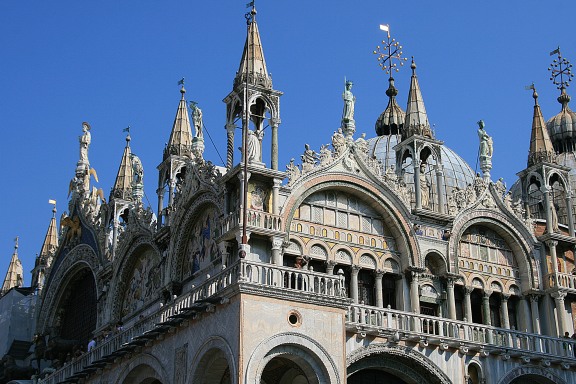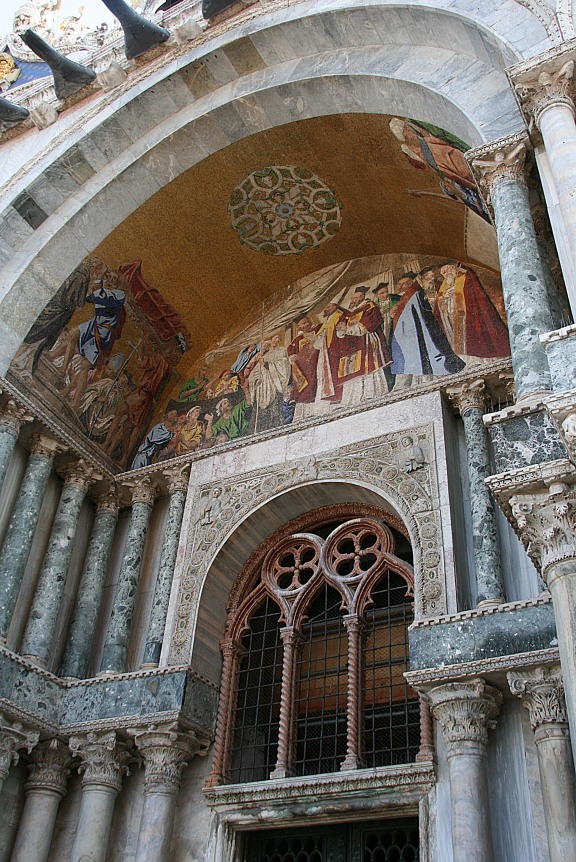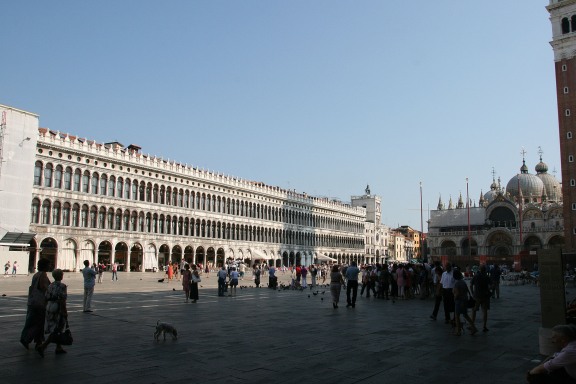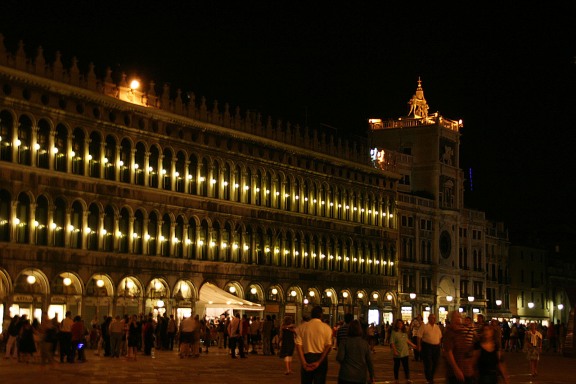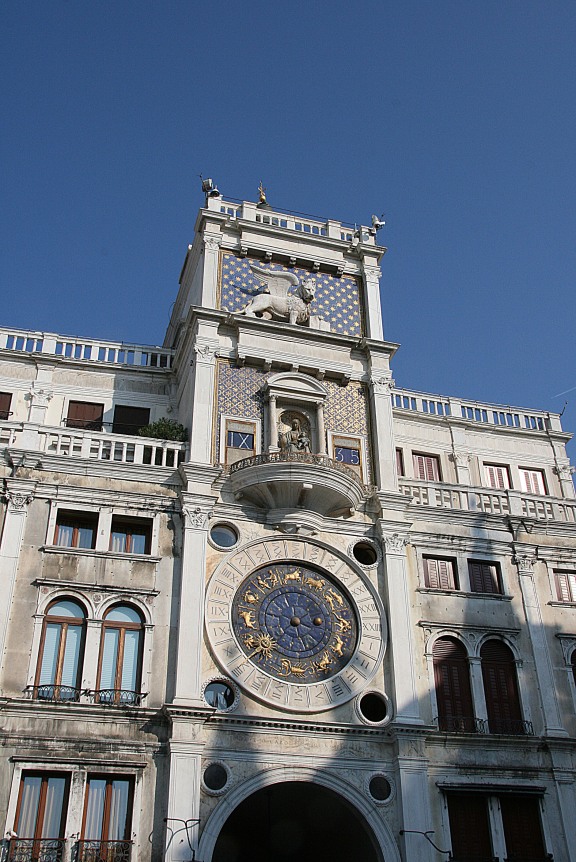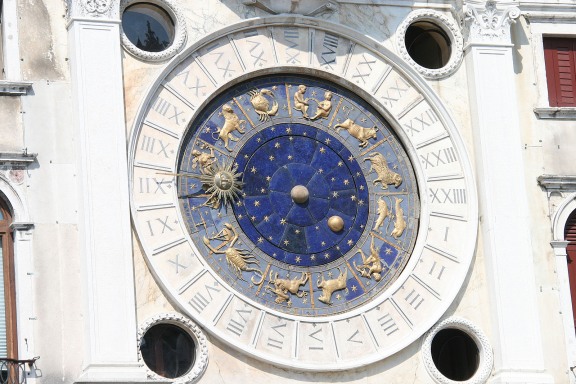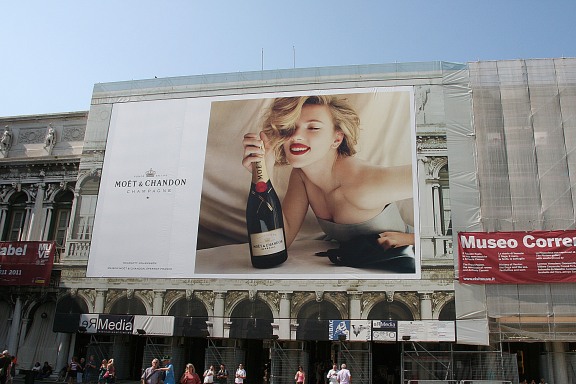On this post, we’re going back to Venice. So, we’ve gone on a gondola ride and visited Piazza San Marco at night. Now we’ll visit the piazza during the day. The truth, we loved it best at night – after the crowds have died down and all you hear are the musicians playing at Caffè Florian and Grancaffè Quadri as couples spontaneously start dancing in the middle of the piazza. That is my memory of Venice.
Basilica di San Marco
The most famous landmark at Piazza San Marco is of course, the Basilica. It is unfortunate that you can’t take photos inside. The interior is filled with dazzling intricate golden mosaics. I found a couple of links that has some pretty awesome photos of the interior from Sacred Destinations (click on the gallery of photos) and World Digital Library (click on “open” at the bottom of the photo on the top left of the page).
When we visited in September of 2011, a portion of the front facade was under construction. I didn’t know much about the Basilica only that it is an example of Byzantine architecture with a floor plan in the shape of the Greek cross. Glad we had a guide to give us some information so we could appreciate what we were looking at. Can you believe that St. Mark’s Basilica used to be the Doge’s chapel? Yup, until it became the cathedral of Venice in 1807. We also learned that the Basilica was decorated from looted treasures brought back to Venice. We’ll see some of those treasures below.
The photo below is detail of the rooftop of the main entrance showing St. Mark and angels crowning the central arch. Under the statue of St. Mark’s is the symbol of Venice – St. Mark’s Lion (with an open book). The significance of the open book? Not sure. I did a quick search and there are only speculations as to its meaning. St. Mark’s Lion has also been depicted with a closed book or a sword under its paw.
On the balcony, are the famous four horses of St. Mark’s (replicas, of course). Short history of the four horses – they are life-sized bronze sculptures looted from Constantinople during the crusades in the early 13th century. Napoleon then took them to France in 1797 and eventually brought back to Venice in 1815. About 20 years ago, the original horses were brought inside for protection. There you have it – thank you Wikipedia.
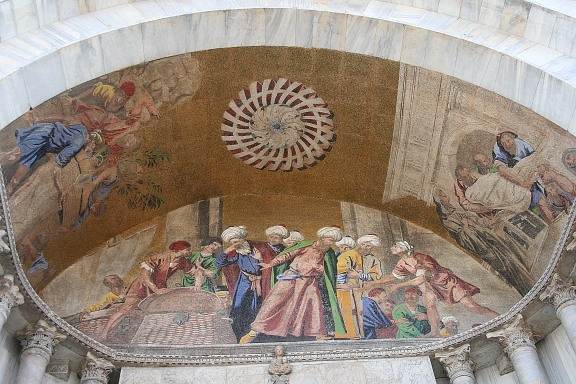
Mosaic located at the front of the basilica showing the body of St. Mark’s being taken from Alexandria (actually more like “stolen”) by Venetian merchants and hidden under slices of pork to smuggle it past the Muslim guards.
There were so many people in the piazza that it was difficult to take photos, especially on the south side of the Basilica closest to the Doge’s Palace. Anyway, I managed to take the photos below of one of the free-standing columns and the sculpture called the “Tetrachs”.

The Tetrachs, a sculptured group in porphyry (4th century Egyptian) is thought to represent Diocletian, Maximilian, Valerian and Constantine. Collectively they were the Tetrachs, appointed by Diocletian to help rule the Roman Empire. (Eyewitness Travel)
If you’ve read my previous posts, then you know I love 360 views and I found one right infront of the Basilica here! It’s really the closest to taking you there myself 🙂
If you stand infront of the Basilica, the structure to your left were the offices of the highest officials of Venice. On this side, you will find Grancaffè Quadri. The bottom portion of these buildings are shops. There is an alley about halfway down (if you walk away from the Basilica) that leads to one of the the gondola stations should you wish to go on a ride.
Our next stop is that tower to the right on the photo below.
Clock Tower
The Torre dell’Orologio, has been serving Venice since its inauguration in 1499 and is the official timekeeper of Venice. The tower dates back to the early renaissance, late 15th century. You can actually go up the tower but you must book your tour in advance.
If you look at the photo below, see where the bell is? There are two bronze figures that come out and strike the bell at each hour. Can you see the hammer striking the bell? Right under the terrace is St. Mark’s Lion, the symbol of Venice, with an open book.
Right under St. Mark’s Lion is a statue of the Virgin Mary and Child. On either side are blue panels that show the time. The panel on the left with the Roman numerals show the hour and the number to the right of the statue show the minute (it changes every 5 minutes). You see that semi-circular gallery in front of the statute? Twice a year, at Epiphany and Ascension Day, the three Magis emerge through one of those blue panels as they pass in front of the statue, around the gallery and exit through the other blue panel.
Below the panel of the Virgin Mary and Child statue is the clock. As you can see from the photo below, the hours are shown in Roman numerals with an inner circle showing the signs of the zodiac. The hour pointer is in the image of the sun. The inner circle of zodiac symbols also rotate so that it shows the zodiac position in relation to the sun. There are two circular shapes in the middle where the blue panels are decorated in blue and gold stars – those two circular shapes represent the earth (in the middle) and the moon which also revolves to show its phases. What a clock! I personally just need to know the time or I guess in this case, the approximate time as it only changes every 5 minutes.
There is an archway right underneath the clock tower that opens to the main shopping streets of Venice that lead to the Rialto Bridge (just follow the signs). Once you go through those arches, you may feel like you’re in a maze and wonder how you’ll ever find your way out – just follow the signs and you won’t get lost.
Museo Correr
Right across from the Basilica on the opposite side of the piazza is the Museo Correr or The Museum of the City and Civilization of Venice. When we were there, it was covered by a huge advertisement. Garish, isn’t it? The Venetians don’t like it (according to our guide) but that’s how the repairs get paid for.
I would love to visit Venice again after all the repairs are done. Here’s a little taste of what the facade might look like. Love the detail on the window arches!
If you’re standing in front of Museo Correr, to your left are more former offices of the officials of Venice. Today, it houses the Museo Archeologico and state library. I didn’t seem to take any photos of this side except for those of Caffè Florian, one of the oldest cafes in Europe dating back to the early 18th century.
By the way, if you’re wondering what happened to all the pigeons that Piazza San Marco is famous for – they were still around but not many. Venice has tried to rid of what they’ve been referred to as “rats with wings”. They were also destroying the buildings, so you’ll see little metal wires sticking from ledges to prevent them from hanging around.
P.S. Just a helpful tip passed on to us by our guide: The streets of Venice are very narrow. We even saw some walkways with very low ceilings (check out the photo below). To keep the flow of foot traffic going, please walk on the right and preferably keep walking! The worst thing to do is for a big group of people to stand in the streets gawking at the store fronts. If you want to window shop, may I suggest to do it at night when there aren’t as many people around? The shop windows are lit and I have to admit, it was fun wandering through those darkened streets at night. Happy exploring!


